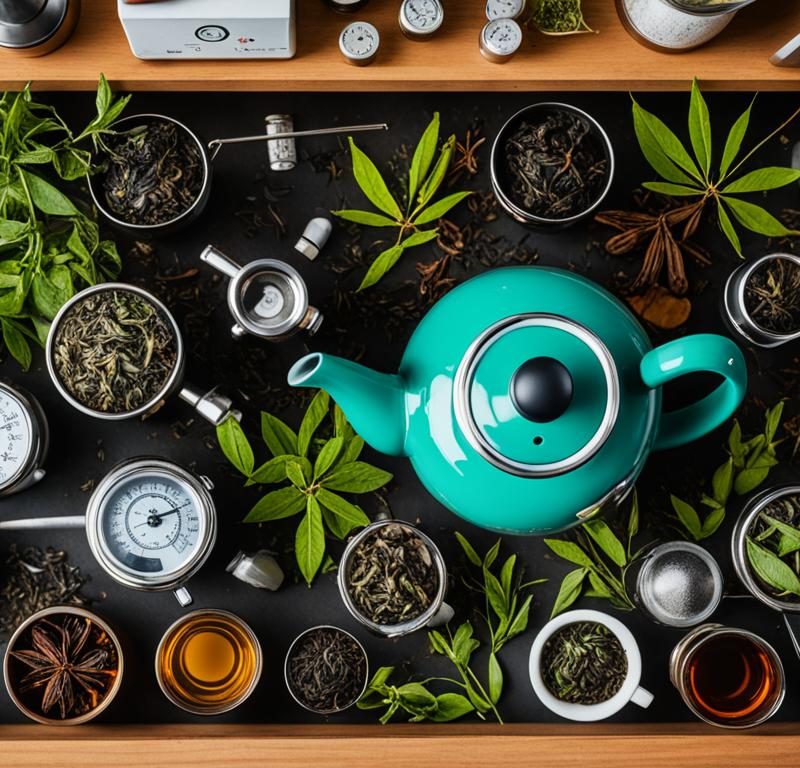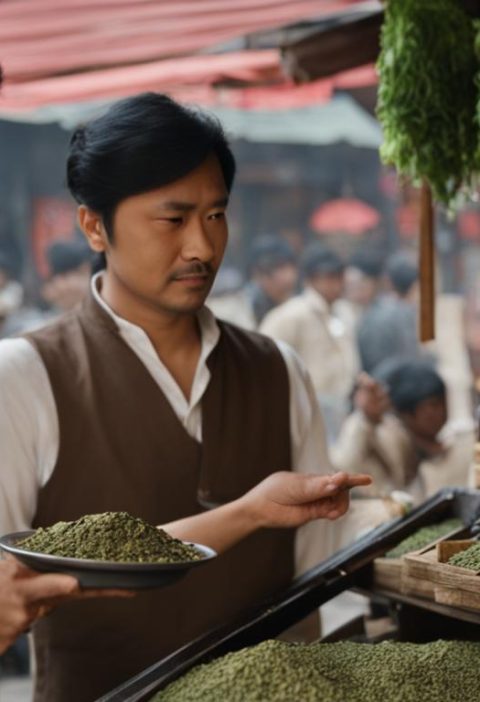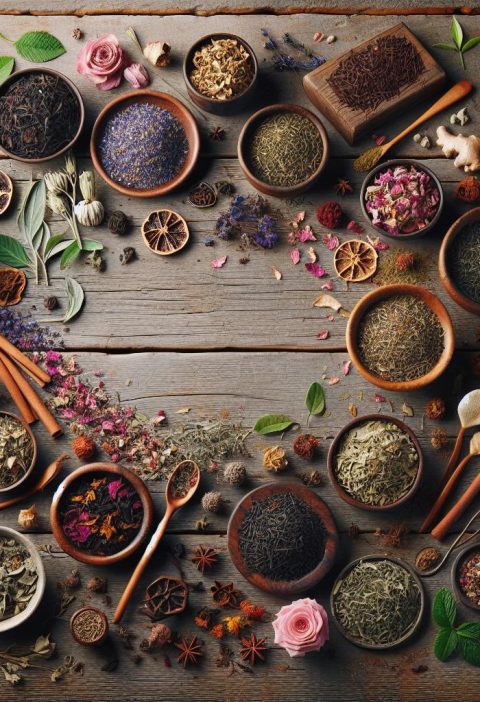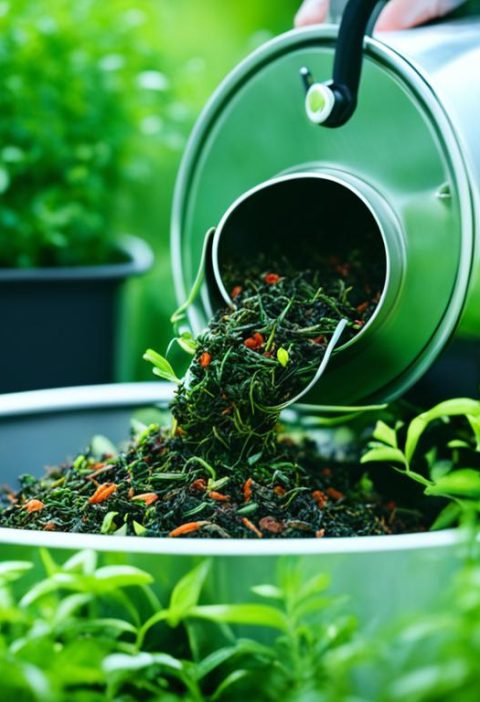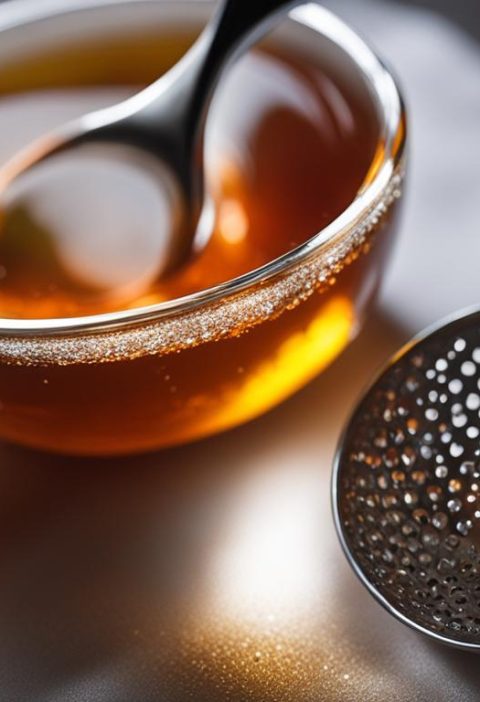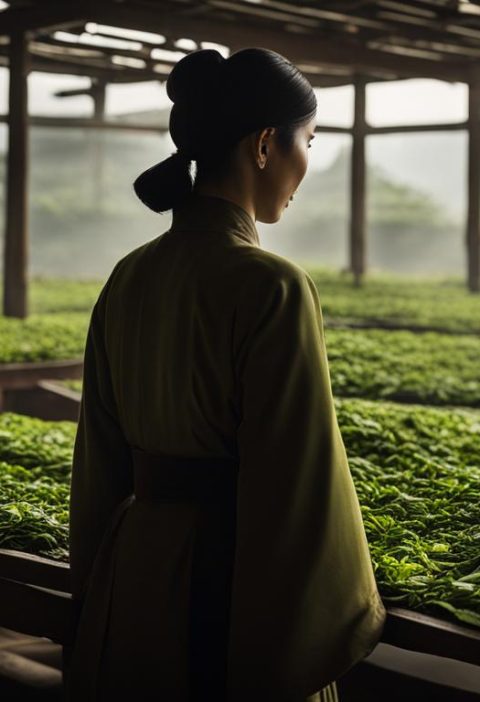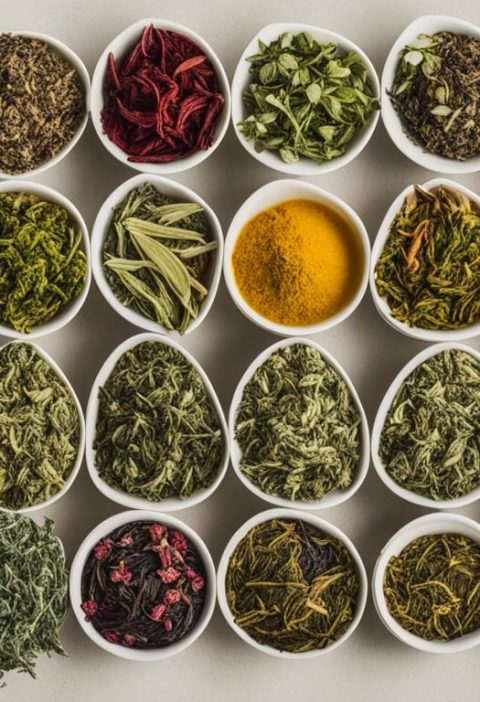Brewing the perfect cup of loose leaf tea requires attention to detail and understanding of the brewing process. From selecting high-quality tea leaves to mastering steeping techniques, every step plays a crucial role in achieving a flavorful and aromatic cup of tea.
Key Takeaways:
- Select high-quality loose leaf tea for better flavor and aroma.
- Use fresh, filtered water to enhance the taste of tea.
- Mind the steeping time to control the strength and flavor.
- Invest in a good-quality teapot or infuser for proper extraction.
- Enjoy the mindful experience of brewing and sipping tea.
As a passionate tea enthusiast and experienced tea brewer, I have discovered that brewing loose leaf tea is an art that requires patience and precision. Through my years of exploration and experimentation, I have honed my skills in achieving the perfect cup of loose leaf tea. I understand the nuances of selecting the right tea leaves, controlling water temperature, and ensuring optimal infusion time. With this unique perspective and expertise, I am excited to share actionable insights and tips to help you master the art of brewing the perfect cup of loose leaf tea.
Start with High-Quality Tea Leaves
When it comes to brewing the perfect cup of tea, the quality of the tea leaves is paramount. Opting for high-quality loose-leaf tea instead of tea bags ensures a more flavorful and aromatic experience. The loose leaves offer a rich and complex flavor profile that is often missing in pre-packaged tea bags.
To begin, measure the tea leaves according to the recommended ratio. As a general guideline, use about one teaspoon of loose-leaf tea for every 8 ounces of water. However, feel free to adjust the measurements based on personal preference and cup size. Experimenting with different ratios can help you find the perfect balance of flavors.
Using high-quality loose-leaf tea sets the stage for a remarkable tea brewing experience. The superior taste and aroma will elevate your tea-drinking ritual to new heights.
Benefits of High-Quality Loose-Leaf Tea:
- Enhanced flavor and aroma
- Greater complexity in taste
- Richer color and appearance
- More sustainable option compared to tea bags
Achieving the Perfect Brew:
| Tea Type | Recommended Tea-to-Water Ratio |
|---|---|
| Black Tea | 1 teaspoon per 8 ounces of water |
| Green Tea | 1 teaspoon per 8 ounces of water |
| Oolong Tea | 1 teaspoon per 8 ounces of water |
| White Tea | 1 ½ teaspoons per 8 ounces of water |
| Herbal Tea | 1 ½ teaspoons per 8 ounces of water |
Remember, brewing tea is an art, and starting with high-quality loose-leaf tea is the first step toward a sublime tea-drinking experience. So, choose your favorite loose-leaf tea blend, savor the aroma, and embark on a journey of flavor. Enjoy!
Use Fresh, Filtered Water
The quality of water used for brewing tea significantly affects the taste. When preparing your loose leaf tea, it is important to use fresh, cold, and filtered water whenever possible. Fresh water ensures that the flavors of the tea are not compromised and allows for a pure and clean taste experience.
Filtered water is preferred as it removes impurities and chemicals that can alter the flavor of the tea. By using filtered water, you can enhance the natural flavors and aromas of your tea, resulting in a more enjoyable and satisfying cup.
Avoid reusing water that has been sitting for too long in the kettle, as it may have absorbed odors or acquired a stale taste. Starting with fresh water for each brewing session ensures a consistent and vibrant flavor profile.
It is worth noting that different types of tea require specific water temperatures for optimal flavor extraction. Let’s take a closer look at the recommended water temperatures for different types of tea:
| Tea Type | Water Temperature |
|---|---|
| Green Tea | 160°F – 180°F (71°C – 82°C) |
| Black Tea | 200°F – 212°F (93°C – 100°C) |
| Oolong Tea | 190°F – 200°F (88°C – 93°C) |
| White Tea | 160°F – 180°F (71°C – 82°C) |
| Herbal Tea | 200°F – 212°F (93°C – 100°C) |
By using water at the appropriate temperature, you can ensure that the flavors of the tea are extracted optimally, resulting in a well-balanced and flavorful cup.
Mind the Steeping Time
The steeping time plays a crucial role in unlocking the optimal strength and flavor of your loose leaf tea. It is important to understand the general guidelines for different types of tea, as well as to experiment and adjust the steeping time to suit your personal preference. To ensure consistency in your brews, using a timer can be extremely helpful.
| Type of Tea | Steeping Time |
|---|---|
| Green Tea | 1-3 minutes |
| Black Tea | 3-5 minutes |
| Oolong Tea | 3-6 minutes |
| Herbal Tea | 5-7 minutes |
These are general recommendations, but feel free to experiment and adjust the steeping time based on your taste preferences. Remember that steeping for too long can result in a bitter taste, while steeping for too short a time may lead to a weaker brew with less flavor.
Fun fact: Did you know that some teas, like white tea, may benefit from longer steeping times to enhance their delicate flavors? It’s all part of the tea brewing adventure!
Use the Right Teapot or Infuser
To fully unlock the flavors and aromas of loose leaf tea, it is essential to use the right teapot or infuser. Investing in a good-quality teapot or infuser not only enhances the brewing process but also ensures a more enjoyable tea-drinking experience. Let’s explore some options:
1. Teapot
A teapot is a classic and versatile option for brewing loose leaf tea. It allows for larger quantities of tea to be brewed at once, making it ideal for sharing with friends or family. Look for teapots made from materials like glass, ceramic, or clay, as they help retain heat and are aesthetically pleasing.
Here’s a table comparing different types of teapots:
| Type of Teapot | Features | Pros | Cons |
|---|---|---|---|
| Glass Teapot | Transparent, allows for visually appealing brewing experience. Heat-resistant. | – Elegant design – Allows the beauty of the tea leaves to be showcased – Suitable for blooming teas |
– May require careful handling to prevent breakage – Heat loss over time |
| Ceramic Teapot | Durable, retains heat well. Available in a variety of colors and designs. | – Retains heat better than glass teapots – Wide variety of options to suit personal style – Can be dishwasher safe |
– May be on the heavier side – Overheating can cause cracking or damage |
| Clay Teapot | Known for heat retention and enhancing the tea’s flavor. Multiple sizes and styles available. | – Enhances the tea’s aroma and taste – Heat retention reduces the need for frequent reheating – Traditional and authentic brewing experience |
– Requires careful cleaning and seasoning – Not always dishwasher safe |
2. Infuser
An infuser is a convenient and portable option for brewing loose leaf tea. It allows for individual servings and ensures easy cleanup. There are various types of infusers available, such as steeping baskets, tea balls, and tea sticks. For the best brewing experience, we recommend using steeping baskets.
Here’s a table comparing different types of infusers:
| Type of Infuser | Features | Pros | Cons |
|---|---|---|---|
| Steeping Basket | Roomy design that provides ample space for tea leaves to expand. | – Allows tea leaves to fully unfurl and release flavors – Easy to clean and maintain – Suitable for different types of teas |
– Requires a separate cup or mug for brewing – May release some residue into the cup |
| Tea Ball | A small, perforated metal ball that holds tea leaves during steeping. | – Portable and convenient – Easy to use and clean – Suitable for fine tea leaves or herbs |
– Limited space for leaves to expand – May restrict the infusion process |
| Tea Stick | A long, narrow infuser resembling a spoon or straw. | – Convenient and mess-free – Allows for precise control of steeping time – Ideal for teas with larger leaves or flowers |
– Limited space for leaves to expand – May not be suitable for finely ground tea or herbs |
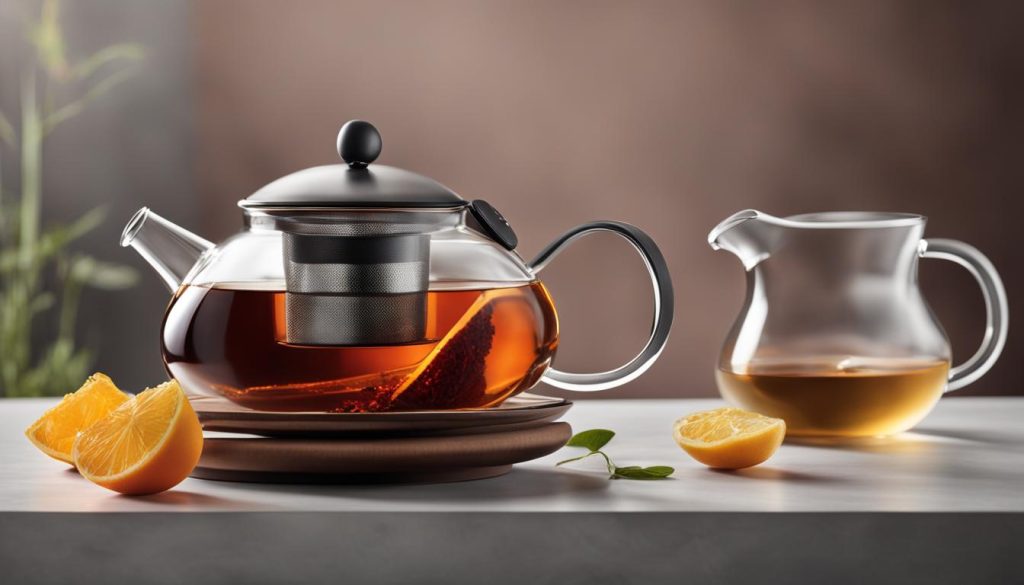
By choosing the right teapot or infuser, you can ensure the full potential of loose leaf tea is realized in every cup. Whether you prefer the elegance of a teapot or the convenience of an infuser, the choice is yours. Experiment with different brewing methods and find the perfect equipment that suits your taste and brewing style.
Pour and Sip Mindfully
Once the tea has steeped to perfection, it’s time to pour and savor the mindful experience of tea sipping. There’s something enchanting about the delicate ritual of pouring tea into your favorite cup or mug. It’s a moment of anticipation, knowing that you are about to indulge in a soothing and aromatic infusion.
Before diving into the first sip, take a moment to inhale the enchanting aroma that wafts from your cup. Close your eyes and let the scent transport you to serene tea gardens and lush landscapes. Allow the fragrance to awaken your senses, preparing your palate for the flavors to come.
When you finally take that first sip, do so slowly and consciously. Let the warmth of the tea embrace your mouth, delicately exploring every taste bud. Pay attention to the interplay of flavors, from the subtle sweetness to the complex undertones that gradually unfold.
Savor each sip, relishing the harmonious dance of flavors on your tongue. Notice the way the tea caresses your palate and leaves a gentle aftertaste. Mindful tea brewing invites us to be fully present and engaged with each sip, turning a simple act into a transformative experience.
As you sip mindfully, embrace the moment of tranquility that tea brings. Pause, breathe, and let the stress of the day melt away. Allow the flavors of the tea to awaken your senses and bring a sense of calm and rejuvenation, creating a moment of inner peace.
Brewing tea goes beyond the mechanics of steeping; it’s an art that nourishes the mind, body, and soul. So, the next time you brew a cup of loose-leaf tea, remember to pour and sip mindfully, embracing the beauty and serenity that the experience offers.
Essence of Steeping: Unlocking Flavor and Complexity
Steeping is the heart of tea brewing, where the tea leaves are infused with hot water to extract their unique character. It is during this process that the flavors and aromas of the tea come alive, creating a delightful sensory experience for tea lovers.
When it comes to steeping loose-leaf tea, quality matters. The use of high-quality loose-leaf tea allows for a more complex flavor profile and a deeper, more nuanced aroma. Loose-leaf tea leaves are whole and intact, which allows for better extraction of the tea’s natural oils and flavors.
The balance between tea and water is also a key factor in steeping. Finding the right ratio ensures that the flavors are not overpowering or diluted. It is recommended to follow the specific steeping instructions provided for the type of tea you are brewing, as different teas require different steeping times and water temperatures to achieve the best flavor extraction.
The Art of Steeping Loose Leaf Tea
To unlock the full potential of your tea, follow these simple steps:
- Boil fresh, filtered water to the appropriate temperature based on the tea type.
- Measure the recommended amount of loose-leaf tea based on the desired strength.
- Place the tea leaves in a tea infuser or teapot.
- Pour the hot water over the tea leaves, covering them completely.
- Allow the tea leaves to steep for the recommended time, keeping in mind that longer steeping times may result in a stronger flavor.
- Once the steeping time is complete, remove the tea leaves or strain the tea to prevent over-extraction.
- Sit back, relax, and enjoy the rich, flavorful cup of tea you have created through the art of steeping.
The above image visually represents the essence of steeping tea, capturing the moment when the tea leaves impart their flavors and aromas into the water. It serves as a visual reminder of the magic that happens during the steeping process.
The Dance of Timing: A Fusion of Science and Intuition
When it comes to brewing the perfect cup of tea, timing is everything. The steeping time plays a crucial role in extracting the optimal flavors from your loose leaf tea. Different types of tea require different steeping times to unlock their full potential. Get ready to embrace the art of timing as we explore the science and intuition behind steeping your favorite brew.
Steeping Time Guidelines
Steeping times can vary depending on personal preference and the type of tea you’re brewing. It’s important to experiment and find the balance that suits your taste buds. To get you started, here are some general guidelines to follow:
- Green Tea: 1-3 minutes
- Black Tea: 3-5 minutes
- Oolong Tea: 3-5 minutes
- White Tea: 4-6 minutes
- Herbal Tea: 5-7 minutes
Keep in mind that these are just basic recommendations, and you can always adjust the steeping time to your liking. The goal is to find the perfect balance of flavors in each cup of tea you brew. Remember, patience is key!
Oversteeping your tea can lead to bitterness, overpowering the delicate flavors. On the other hand, understeeping may result in a weak brew, leaving you yearning for more robust flavors. Trust your intuition as you gain experience in tea brewing and explore the diverse range of flavors that emerge with different steeping times.
Timing Chart: Steeping Time Guidelines
| Tea Type | Steeping Time |
|---|---|
| Green Tea | 1-3 minutes |
| Black Tea | 3-5 minutes |
| Oolong Tea | 3-5 minutes |
| White Tea | 4-6 minutes |
| Herbal Tea | 5-7 minutes |
Remember to adjust the steeping time based on your personal taste preferences. Don’t be afraid to explore and experiment with different steeping times to find the perfect balance of flavors for your cup of tea.
Let your tea steep to perfection, and you’ll soon discover the delightful nuances and intricate flavors that await in every sip. Happy brewing!
Temperature: The Dynamics of Flavor Extraction
The temperature of the water used for brewing tea plays a crucial role in extracting the rich flavors and aromatic compounds from the tea leaves. Different types of tea require specific water temperatures to unlock their full potential. To achieve the perfect brew, it’s important to understand the relationship between water temperature and tea solubility.
Tea Solubility and Water Temperature
Tea solubility refers to the ability of the tea compounds to dissolve in water, releasing their flavor, color, and aroma. The solubility of these compounds is influenced by the temperature of the water. As the water temperature increases, more compounds are extracted from the tea leaves, intensifying the flavors.
However, it’s crucial to note that different types of tea have varying degrees of solubility. Steeping tea at the wrong temperature can result in an imbalanced or lackluster cup of tea. To fully appreciate the flavors of different tea varieties, it’s essential to brew them at the recommended water temperature.
Recommended Water Temperatures for Various Teas
Below is a table detailing the recommended water temperatures for popular types of tea:
| Tea Type | Water Temperature |
|---|---|
| Green Tea | 160°F – 180°F (71°C – 82°C) |
| White Tea | 160°F – 180°F (71°C – 82°C) |
| Oolong Tea | 190°F – 200°F (88°C – 93°C) |
| Black Tea | 200°F – 212°F (93°C – 100°C) |
| Herbal Tea | 200°F – 212°F (93°C – 100°C) |
By following these temperature guidelines, you can ensure that the flavors of each tea type are brought to their fullest potential, resulting in a satisfying and nuanced cup of tea.
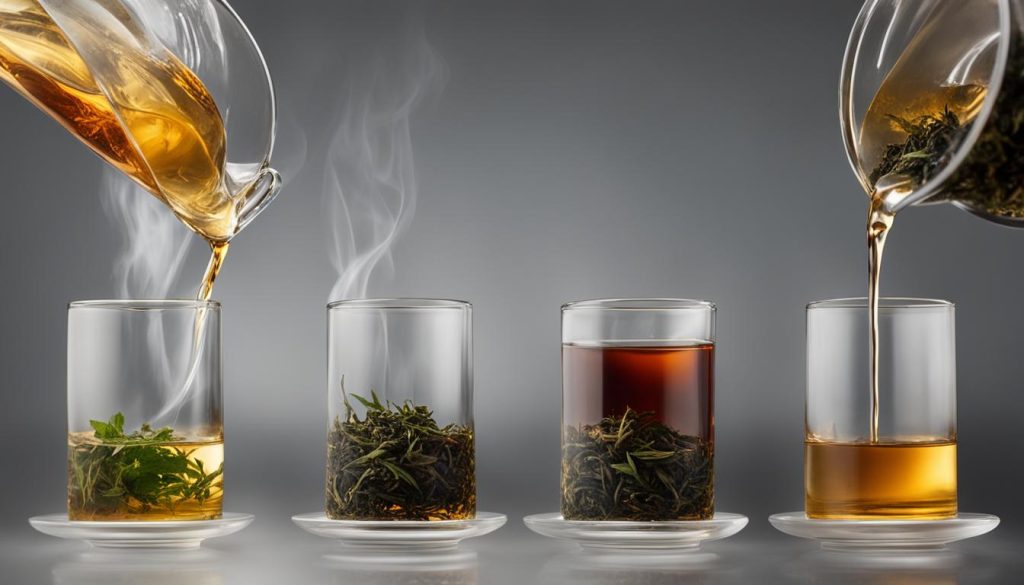
Image: Water temperature plays a vital role in achieving the perfect cup of tea.
The Ritual of Preparation: A Path to Mindful Brewing
Brewing tea is more than a mechanical process; it is a mindful ritual that engages all the senses. When it comes to tea, the journey starts long before the first sip. It begins with the careful selection of tea leaves that resonate with your mood and the moment.
As you embark on the path of mindful tea brewing, take a moment to appreciate the sound of water coming to a gentle boil. Close your eyes and inhale the intoxicating aroma of the dry leaves, savoring the anticipation of the flavors that will soon unfold.
Once you have chosen the perfect tea, infuse intention into each step of the brewing process. Pay attention to the water temperature, the steeping time, and the vessel you use. Let your actions be deliberate and purposeful, allowing yourself to be fully present in the moment.
As you pour the tea into your cup, watch as the delicate colors dance in the liquid, creating a visual symphony. Bring the cup to your lips, feeling the warmth radiate through your hands, and take a slow, deliberate sip. Allow the flavors to caress your taste buds, immersing yourself in the meditative experience of tea drinking.
Take this opportunity to disconnect from the chaos of daily life and reconnect with yourself. Let the tea be a source of comfort, tranquility, and inspiration. Embrace the mindfulness of tea brewing, and let it be a gentle reminder to find joy and peace in the simple moments.
Benefits of Mindful Preparation:
- Enhanced sensory experience: By engaging all your senses, mindful tea preparation elevates the experience, allowing you to fully appreciate the flavors, aromas, and textures of the tea.
- Stress relief: The focused and deliberate process of brewing tea can serve as a form of meditation, helping to reduce stress and promote relaxation.
- Mindfulness practice: Brewing tea mindfully can serve as a gateway to incorporating mindfulness into your daily routine, fostering a greater sense of presence and self-awareness.
- Ritual and self-care: Taking the time to prepare and savor a cup of tea is an act of self-care, creating a moment of pause and rejuvenation in your day.
| Tea Ritual Essentials | Benefits |
|---|---|
| A quiet, peaceful environment | Allows for focused and undisturbed tea brewing |
| A favorite teapot or infuser | Enhances the visual appeal of tea brewing and facilitates optimal infusion |
| A selection of high-quality loose leaf teas | Ensures the utmost flavor and aroma in every cup |
| A timer or stopwatch | Helps maintain consistent steeping times for optimal flavor extraction |
| A comfortable, cozy spot for tea enjoyment | Creates an inviting atmosphere for savoring the mindfulness of tea drinking |
Experimentation and Evolution: Your Personal Tea Odyssey
Embark on a fascinating tea brewing journey that is as unique as your personal preferences. The art of brewing tea is a delightful exploration and a limitless opportunity for experimentation. Join us as we celebrate the joys of discovering new flavors, perfecting brews, and embracing the ever-evolving world of loose leaf tea.
Let your taste buds guide you as you try different tea-to-water ratios, allowing for variations in strength and character. Explore unconventional brewing methods, such as cold steeping or tea-infused cocktails, to unlock unexpected flavor profiles. The beauty of loose leaf tea lies in its versatility and ability to adapt to your desired taste.
Tea brewing is best enjoyed when shared with others. Invite friends or loved ones to join you on this tea brewing odyssey. Experiment together, exchange brewing tips, and savor the diverse experiences that each cup brings. Engage in thoughtful conversations and create cherished memories with every sip.
Indulge in the rich tapestry of loose leaf tea, discovering the nuances and complexities that make each brew a unique and individual experience. Embrace the evolution of your personal tea preferences as you refine your techniques and uncover new favorites along the way. Allow your tea brewing journey to be an expression of who you are, celebrating the beauty of a perfectly brewed cup of tea that reflects your own taste and style.
